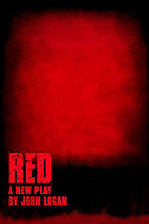 First, my apologies for abandoning the blog for so long. It has been an eventful few months (in a good way), and I’ve put this on the back burner for a while. I’ve had plenty to write about but not time. One example: the play, Red, at the Berkeley Repertory Theatre. I can’t say it’s fresh from it’s Tony-winning Broadway run, but it did make it out west more quickly than most.
First, my apologies for abandoning the blog for so long. It has been an eventful few months (in a good way), and I’ve put this on the back burner for a while. I’ve had plenty to write about but not time. One example: the play, Red, at the Berkeley Repertory Theatre. I can’t say it’s fresh from it’s Tony-winning Broadway run, but it did make it out west more quickly than most.
Red opens in Rothko’s studio in the late ‘50s and we meet the artist as he is interrogating a potential new assistant, Ken, who represents the generation of artists who will follow the Abstract Expressionists.
Abstract Expressionism as a movement – within which Rothko’s work is categorized – is seen as either the apotheosis or destruction of modernism. Defining modernism (specifically as it relates to art) is tricky and is freighted with a ton of judgements based on one’s own opinion of whether modernism was good or bad. As part of a full disclosure, I don’t see modernism as anything inherently bad but as a good philosophy poorly devised to the artistic heirs of the next generation.
The central relationship in Red demonstrates this dynamic. It is modernism as the idea that art is progressive and significant and in each new movement there is a march towards something vibrant and new: art matters. But, in the waining days of the movement, the Abstract Expressionists seemed more intent on protecting their own legacy rather than helping the next genration understand what it all meant.
Abstract Expressionism may be the last moment in time when art was important and revered. When being an artist required intellectual depth and an understanding of what had gone before. There are moments early in Red when Rothko attempts to convey these basic tenets. But it doesn’t last long as Rothko becomes absorbed with self-importance and the meaning of his own work.
From the middle to the end of the play, we see a fragile Rothko who is not generous enough to acknowledge that something will come after him. One of the most frightening moments in the play is when Rothko flies into a rage when Ken makes a color suggestion on one of Rothko’s paintings-in-progress. In this scene, we see the first glimpse of Rothko’s fear – that was likely shared with many Abstract Expressionists – that, while so close to fulfilling modernism’s promise, he would ultimately fail. Perhaps jealous of the next generation who would stand on the shoulders of giants to fulfill the promise of modernism, Rothko chooses to withdraw from Ken and deny him the benefit of Rothko’s experience and wisdom.
Black swallows red had little to do with Rothko’s own fear of mortality and everything to do with foreshadowing the death of modernism. The blackness of frivolity and absence of meaning and superficiality. The idea that the Abstract Expressionists destroyed modernism meets little resistance in contemporary art; it also elicits little sadness at what could have been with if the Abstract Expressionists had been mentors to the next generation rather than viewing that generation as competition.
By the end of the play, we see a Rothko who has nothing left to give but empty admonitions. “Make something new,” Rothko says to Ken with resigned hope but mostly sadness knowing that what he’s asking is impossible. Rothko is merely echoing the modernist charge attributed to Ezra Pound (“make it new”), but the young artists represented by Ken more likely viewed this as a taunt. Nothing new was left, which explains the anger and disillusionment of subsequent generations and their complete rejection of modernism as a philosophy of art.
